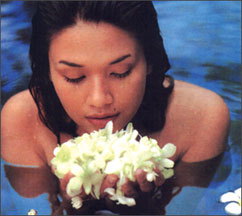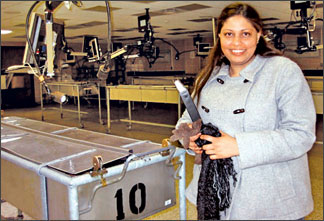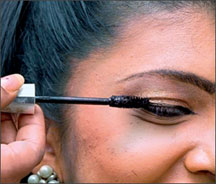
Where love ’n beauty blossom
Caryl NUGARA
|

Flowers spell out nature’s beauty, love and purity
|
Flowers are the loveliest of earth’s adornments. Whether wild or
propagated they are part of nature’s beauty. Flowers act natural
accessory to enhance female beauty.
As early as the sixth century, King Nebuchadnezzar built the Hanging
Gardens of Babylon yet considered a wonder of the world.
The Elamite city of Susa had perfect gardens long before the
Christian Era. Assiriya, Sumer and Egypt were proud of areas unique for
flowers.
Persia was the most important horticultural region in the world and
flowers such as crocus, cornflower, lily and amaryllis are species that
originally grew there. In fact there are flower paintings on some
ancient urns and dishes.
The Cape Jasmine grew on shrubs in American states such as Georgia
and Savannah. The waxy white flowers heavily scented have long tubes and
the other variety is pale yellow with purple impressions.
Margaret Mitchell in her ‘Gone with the Wind’ writes about the
wealthy southern mansions scented with jasmine buds which burst out into
flowers. She also depicts the Magnolia blossoms in spring, white and
fragrant. This flower is yet the emblem of Louisiana and Mississippi.
In the warmer climate of Colorado and the old reservations floral
bouquets of pinky-mauve verbena, sunflowers and yellow brittle-brush odd
to the glory of spring. Even the alluvial slopes of deserts were
enhanced by the wild chicory flower, the pure white primrose and
Beaver-tail blossoms ravishing in reddish pink.
The crepe myrtle bloomed in splendour amidst wisteria tumbling down
in glorious colours.
The Mountain Andromeda grew among the Kentucky Blue Grass and clover
beds. Flowers that needed warmth and moisture like sweet peas, and
cyclamen also grew in abundance. The Columbine, Delphinium dandy tuft,
moss pinks and violets lent their loveliness to summer. The Floribundo
Rose and rhododendron flaunted its clusters of bright flowers.
England had her own species like roses, azaleas and lupins. In Pamela
Harper’s famous collection of flower photography there is an enchanting
one of an old English cottage embraced in a profusion of roses,
buttercups, pansies and Jerusalem sage.
The queens of England admired flowers and had silver bowls of them in
their courts. There is a luxuriant bed of tulips and hydrangeas at
Hampton court making a combination of colours.
Queen Anne’s Lace (the flowers named in honour of her) has an
arrangement of clustered snowy white flower heads on the stem.
Canterbury bells, mimosa, lilac, fragrant sweet peas, briar roses and
“babies’ breath” are delicate and rich in nectar.
In cold countries there were summer flowers like holly-hock,
gladioli, fox-glove and Sweet William in vivid colours. Tubular flowers
like Lilly-of-the-Valley bloom on stems right up to the top. The golden
rod and pussy willow have silky, cylindrical inflorescences. Dahlia,
dandelions and crown-of-thorn grew in hedges.
The gardenia and chrysanthemum are sub-tropical flowers with a
fragrance. Chinese peasants painted them on silk scrolls.
The impressive scarlet poppy was supposed to have blossomed in the
war fields of flanders where several brave soldiers died during the
World War I.
Tulips, belonging to an early period are bulbous flowers, erect and
cup shaped.
They grew abundantly in fields and dykes of the Netherlands.
Canals, ancient grounds and swamp-land that had constant water drifts
were natural places for water lilies, lotus, marsh marigolds and purple
hyacinth. They created a hazy and serene environment ideal for
meditation and healing.
Oriental flowers like plum blossom, mulberry flowers and cherry
blossoms thrived in quiet, untouched places blooming in silver gleaming
mass on their trees.
It is curious some pre-historic people grew flowers for food. The
ancient Mexicans ate dhalia roots and the Chines ate stalks and seeds of
the lotus.
During the Elizabethan Period, mothers grew marigolds which seasoned
their “pot pies” (meat in stew) and salad. Syrup of violets gave a
pleasant taste to puddings and cakes.
Small pastry shells containing custard was garnished with primroses.
Cherry and orange flowers were mixed in a broth or prepared as ice cream
with butterfat and sugar. “Rose pies” were filled with meat and rose
petals. (Funk and Wagnall’s Encyl. Vol. 2)
Flowers were also used as medicine. Foxglove, digitalis, poppy and
sweet scabious each had their medicinal properties.
Roman women, disdainfully proud of themselves applied the lily, a
symbol of purity to cleanse the skin and root of iris as a perfume.
Dissecting dreams
Shanila Perera unmasks her strife in becoming a
doctor:
|

First-year medical student Shanila Perera spends hours in the
gross anatomy lab, exploring the human body with the help of a
cadaver.
|
The medical student peers through her surgical face mask at the
patient’s big toe. Her mentors pick up the scalpel and forceps to
demonstrate. Then she makes the first cut. Amidst the sea of blue forms
and shapes that colour the crinkled surgical scrubs, a halo of light
hovers above the student’s hands as she gets one step closer to becoming
a doctor.
Becoming a doctor just takes time and a lot of work, the student says
while brushing aside the fatigue with a bright smile.
Shanila Perera, 26, is full of smiles when she talks about her first
year as a medical student. “It’s good to be smart, but it’s not all of
it. Hard work has to do a lot with becoming a doctor.”
“It’s good,” she laughs. “I mean it is my dream come true.”
Perera has waited a long time for this moment - with continuous
studying, dissecting, going to class, meeting “patients,” she is
surviving the medical education gauntlet that all physicians endure.
Since the fourth grade, she knew she wanted to be a doctor. Perera
started studying science at age nine and fell in love with it.
“We did all these experiments, and I thought, ‘Wow, this is so
cool,’” she said. By the end of that year, Perera was in love with
science and helping people.
“Medicine was a way to do all of that,” she said. Now a student at
Rosalind Franklin University of Medicine and Science (Chicago Medical
School) in North Chicago, Perera is pursuing her dream. But it was not
easy getting here.
If you want to be a doctor, Perera says, “stay with it.” She had to
try twice before her dream became a reality.
The pre-medical era
Unlike American students applying to U.S. medical schools, Perera had
additional barriers to overcome. Although she struggled with the
language, she excelled in science, double-majoring in biology and
chemistry.
Perera applied to about 20 schools, still, she didn’t get in. But she
didn’t give up. She shadowed a doctor. She did summer research. She got
some clinical experience by volunteering in the community and at
hospitals.
And she enroled in a master’s programme at Rosalind Franklin to study
biomedical sciences. During the one-year programme, Perera took classes
most first-year medical school students take: molecular cell biology,
physiology, biochemistry, neuro science, embryology.
Although she stayed on top of her studies, there were times when she
questioned when and if she would ever get into medical school. “There
were times I cried,” she said. “It was sometimes very stressful.”
The first-year
Eventually Perera re-applied, this time only to Rosalind Franklin,
and got in. “The greatest thing is getting accepted,” Perera said. When
she started medical college, Perera was stressed.
“The first few weeks were, like, ‘Oh my God I need to do well; I need
to study; I don’t know how to manage this time,’” she said. “It’s a
freaking-out period.
“The hardest thing is it’s a lot of classes.” Looking back on her
first two quarters, however, Perera says medical school is not all about
getting an A.
“It’s about studying, knowing my stuff, so I can take care of my
patients,” she said. “I see why it’s important to learn and I try not to
freak out.”
Still Perera calls herself a “nerd” when she talks about how much she
studies. She begins the day at 4:30 a.m., poring over her notes from the
previous day’s classes. Then she studies between labs, classes and
discussion groups.
“I could get a B with less work,” she says, “but in the end, it’s
worth it. When you do something really well, or you see patients -
acting patients - it’s just like, ‘Wow, this is why I’m here.’ It’s good
at that moment.”
First patients
One of the most significant experiences for a medical student is the
gross anatomy lab.
It is here that students meet their first real patients -cadavers -
people who have donated their bodies as a gift to these aspiring
physicians and their future patients.
This lab was Perera’s first cadaver experience. Anatomy is important
because it “teaches you the body. We feel for the liver. We feel for the
spleen. If you know where it is, what it does, how it feels, if you’ve
seen it, you’ll know it better,” she added. But Perera’s favourite
‘patients’ are her peers. Students learn how to treat patients and
diagnose problems by practising on each other.
Perera lets her friend examine her reflexes, eye sight and heartbeat,
before switching roles from patient to doctor. “It tells me that one day
I’m going to do this, and that’s the most meaningful thing for me.”
Future plans
Perera does not know what kind of doctor she wants to be. For now her
plan is to get through the third quarter.
With neuroscience, genetics, biochemistry, more clinical reasoning,
medical ethics and epidemiology, she has a full academic load. As the
medical field becomes more competitive, Perera recommends that aspiring
physicians do internships, explore research options and shadow a doctor.
“If it’s your dream, as long as you work really hard, it will come
true,” she said. “It did for me, even if it was a little later.”
- Medill reports Chicago
Let the eyes talk
What beauty style you prefer, there are eye make up tips that allow
you to be the very best at it. But one thing that should always be
considered is the health of your eyes. Your vision should never be
compromised for makeup and there is really no reason for that to happen
either.
 As you are probably aware eye make up application takes practice and
you will probably need to experiment to find out what eye make up
designs and what eye make up style suits you. As you are probably aware eye make up application takes practice and
you will probably need to experiment to find out what eye make up
designs and what eye make up style suits you.
Your eye make up application will include mascara, eyeliner, and eye
shadow, and knowing how to apply these correctly and how to choose the
right make up for your eye colour will help you to discover the true
secrets to beautiful eye make up colour.
Four steps to beautiful eye make up colour
Choosing the right eye shadow
Choosing the right eye shadow can sometimes be a matter of taste. Eye
shadows come in cream and powder types. Powder is most suited to people
with oily skin. Cream eye shadow is ideal for younger skin as it will
sink into wrinkles and be dissolved in oily skin. If you have uneven
skin tone an eye make up concealer should be applied before your eye
shadow. The best eye make up concealer is one that makes your skin tone.
Choosing the right colour eye shadow
Getting the colour of your eye shadow right is the best way to
achieve beautiful eye make up colour. Browns are generally used for
daytime as these are natural colours. For evening wear and social
occasions you can choose a shade to match the clothes you are wearing.
When choosing make up for your eye colour, you should never choose
the colour of your eyes as this will not draw attention to your eyes and
will have the opposite effect.
Eyeliner Application
Your eyeliner will help to accentuate your eye shadow so it is
imperative that you get this right. Eye pencil is the most commonly
used, although it does not last as long as the liquid form.
For a younger looking eye make up style you could opt for a brownish
coloured eyeliner rather than traditional black. Your eyeliner should go
the whole way along your eyes but should not exceed them.
Using Mascara to Frame
The final step in creating beautiful eye make up color is your
mascara. This can make your eyes really look beautiful and can create an
illusion of dark, long eyelashes. Mascara comes is many different colors
with the most common being black. As with eyeliner, if you wish to
achieve a softer more natural look, you should opt for brown coloured
mascara.
Using these tips not only will you achieve beautiful eye make up
colour but you will also look radiant in the process.
(Eye-make-up-tips)
Womanly Solidarity:
‘Investing in Women and Girls’
Life disowned; yet skilled
and experienced life’s bitter troughs
One’s stature diminished?
No!! Dignity and self respect transcend
You engage in a social contract
independently
Sacrifice the best times of life
for other’s well-being
Your rights and freedom
we shall safeguard and uphold!
Molding the basic unit of society;
your family
Conferring professional judgment
via your career
Cascading guidance unto the young
and tender
With solicitude we act as sentinels,
over you, for your advancement
Certainly you have fulfilled obligations; it’s our turn to “salute you”
indeed.
- Dhiruwani PERERA
|

